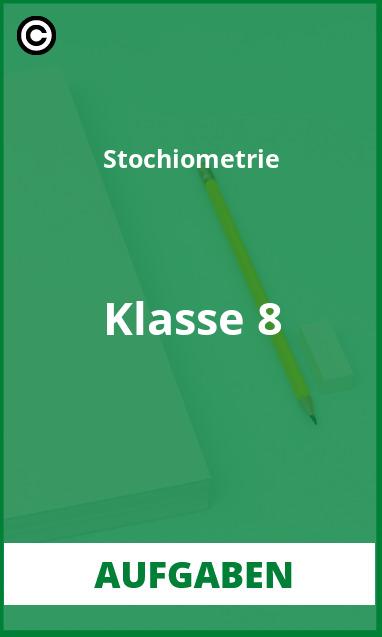
Aufgaben – Stöchiometrie Klasse 8 – Öffnen PDF
Öffnen – Lösungen – Stöchiometrie Klasse 8 PDF
Stoichiometry is the study of the relationship between the reactants and products of a chemical reaction. In other words, it’s a way to calculate the amounts of reactants and products of a reaction from the amount of one of the reactants or products. In this article, we’ll learn the basics of stoichiometry and how to use it to solve some common problems.
In order to understand stoichiometry, we need to first understand the concept of a mole. A mole is a unit of measurement that represents a very large number of things. In chemistry, we use moles to represent the number of atoms or molecules in a sample. For example, one mole of carbon atoms is equal to 6.02 x 1023 atoms. This may seem like a lot, but it’s actually a very useful number to know. By knowing the number of moles of a substance, we can calculate the number of moles of another substance in a chemical reaction.
Now that we know what a mole is, let’s put it to use. Let’s say we have a reaction that looks like this:
This is a very simple reaction, but it’s a good one to start with. We can see that we have 2 moles of substance A and 1 mole of substance B. We want to know how many moles of product C we will get from this reaction.
In order to solve this problem, we need to use a concept called stoichiometric coefficients. These are the numbers in front of the formulas for the reactants and products. In this reaction, the stoichiometric coefficients are 2 and 1. These numbers tell us the ratio of moles between the reactants and products.
We can use this information to set up a simple equation:
This equation says that the number of moles of product C is equal to the number of moles of reactant A divided by the stoichiometric coefficient of A. In this case, that would be 2 moles of A divided by 2, which is equal to 1 mole of C.
We can use this same method to solve for the number of moles of any reactant or product in a reaction. Let’s try another example.
Say we have the following reaction:
This time, we want to know how many moles of product D we will get from 1 mole of reactant C. We can set up our equation like this:
This time, we’re solving for the number of moles of product D, so we start with the number of moles of C and divide by the stoichiometric coefficient of C. This gives us 2 moles of D.
Now that we know how to use stoichiometry to calculate the number of moles of reactants and products, let’s look at how to use it to calculate the mass of a substance. This is a very common application of stoichiometry.
The first thing we need to do is to convert the number of moles of a substance to grams. This is done using a concept called molar mass. Molar mass is the mass of one mole of a substance. For example, the molar mass of carbon is 12.01 grams per mole. This means that one mole of carbon has a mass of 12.01 grams.
We can use molar mass to convert moles to grams like this:
This equation says that the mass of a substance is equal to the number of moles of that substance multiplied by the molar mass of the substance. Let’s try an example.
Say we have 2 moles of substance A with a molar mass of 24.0 grams per mole. We can calculate the mass of A like this:
This gives us a mass of 48.0 grams for substance A.
Now that we know how to use stoichiometry to calculate the mass of a substance, let’s look at how to use it to calculate the volume of a gas. This is also a very common application of stoichiometry.
In order to calculate the volume of a gas, we need to use a concept called molar volume. Molar volume is the volume of one mole of a gas at standard temperature and pressure (STP). Standard temperature is 0 degrees Celsius and standard pressure is 1 atmosphere.
The molar volume of a gas is 22.4 liters per mole. This means that one mole of any gas has a volume of 22.4 liters at STP.
We can use molar volume to convert moles of a gas to liters like this:
This equation says that the volume of a gas is equal to the number of moles of the gas multiplied by the molar volume of the gas. Let’s try an example.
Say we have 2 moles of gas A. We can calculate the volume of A like this:
This gives us a volume of 44.8 liters for gas A.
Now that we know the basics of stoichiometry, let’s put it to use in a real-world example. Say we want to make a solution of hydrochloric acid that has a concentration of 1.0 molar. We know that the molar mass of hydrochloric acid is 36.46 grams per mole, and we know that the molar volume of hydrochloric acid is 22.4 liters per mole. How much hydrochloric acid do we need to make 1.0 liters of solution?
In order to answer this question, we need to set up a stoichiometric equation. We know that we have 1.0 liter of solution, and we know that the concentration of the solution is 1.0 molar. We also know that the molar volume of hydrochloric acid is 22.4 liters per mole. This means that we have 1.0 mole of hydrochloric acid for every 22.4 liters of solution. We can set up our equation like this:
This equation says that the number of moles of hydrochloric acid is equal to the volume of the solution divided by the molar volume of hydrochloric acid. In this case, that would be 1.0 liter of solution divided by 22.4 liters, which is equal to 0.044 moles of hydrochloric acid.
Now that we know the number of moles of hydrochloric acid, we can use the molar mass to convert it to grams. We know that the molar mass of hydrochloric acid is 36.46 grams per mole. This means that we have 0.044 moles of hydrochloric acid for every 36.46 grams. We can set up our equation like this:
This equation says that the mass of hydrochloric acid is equal to the number of moles of hydrochloric acid multiplied by the molar mass of hydrochloric acid. In this case, that would be 0.044 moles of hydrochloric acid multiplied by 36.46 grams, which is equal to 1.59 grams of hydrochloric acid.
This is the amount of hydrochloric acid we need to make 1.0 liter of 1.0 molar hydrochloric acid solution.
Aufgaben mit Lösungen Stöchiometrie Klasse 8
Aufgaben mit Lösungen Stöchiometrie Klasse 8
In diesem Artikel findest du verschiedene Aufgaben zur Stöchiometrie sowie deren Lösungen. Zunächst wird dir die Theorie zur Stöchiometrie erläutert, bevor du anhand von Übungen das Gelernte anwenden kannst.
Theorie
Die Stöchiometrie ist die Lehre von der Massenverteilung bei chemischen Reaktionen. Um die Massenverteilung bei einer Reaktion berechnen zu können, muss man zunächst diejenigen Elemente und Verbindungen bestimmen, die an der Reaktion beteiligt sind.
In den meisten Reaktionen werden die beteiligten Elemente und Verbindungen in unterschiedlichen Mengen umgesetzt. Die Mengenangaben nennt man auch Stöchiometrie. Die Stöchiometrie ist also die Berechnung der Mengenangaben bei einer Reaktion.
Die Berechnungen der Stöchiometrie erfolgen nach dem sogenannten Stoßgesetz. Danach ist die Masse eines Elementes oder einer Verbindung, die an einer Reaktion beteiligt ist, proportional zur Stöchiometrie.
Das heißt, wenn bei einer Reaktion zwei Atome des Elements A mit einem Atom des Elements B reagieren, so sind die beiden Atome A genauso häufig an der Reaktion beteiligt wie das Atom B.
Außerdem gilt für jede Reaktion das sogenannte Äquivalenzgesetz. Danach sind die beteiligten Elemente und Verbindungen in einem bestimmten Verhältnis zueinander. Dieses Verhältnis wird als Äquivalenz bezeichnet.
Zum Beispiel ist das Äquivalenzverhältnis von Sauerstoff und Stickstoff bei der Reaktion von Sauerstoff mit Stickstoff 1 : 3.
Das bedeutet, dass für jedes Atom Sauerstoff drei Atome Stickstoff an der Reaktion beteiligt sind.
Übungen
Nachdem du die Theorie gelernt hast, kannst du mit den folgenden Übungen dein Wissen testen.
1. Rechne die folgende Reaktion um:
2 mol Sauerstoff reagieren mit 3 mol Stickstoff Lösung: 2 mol Sauerstoff reagieren mit 9 mol Stickstoff






